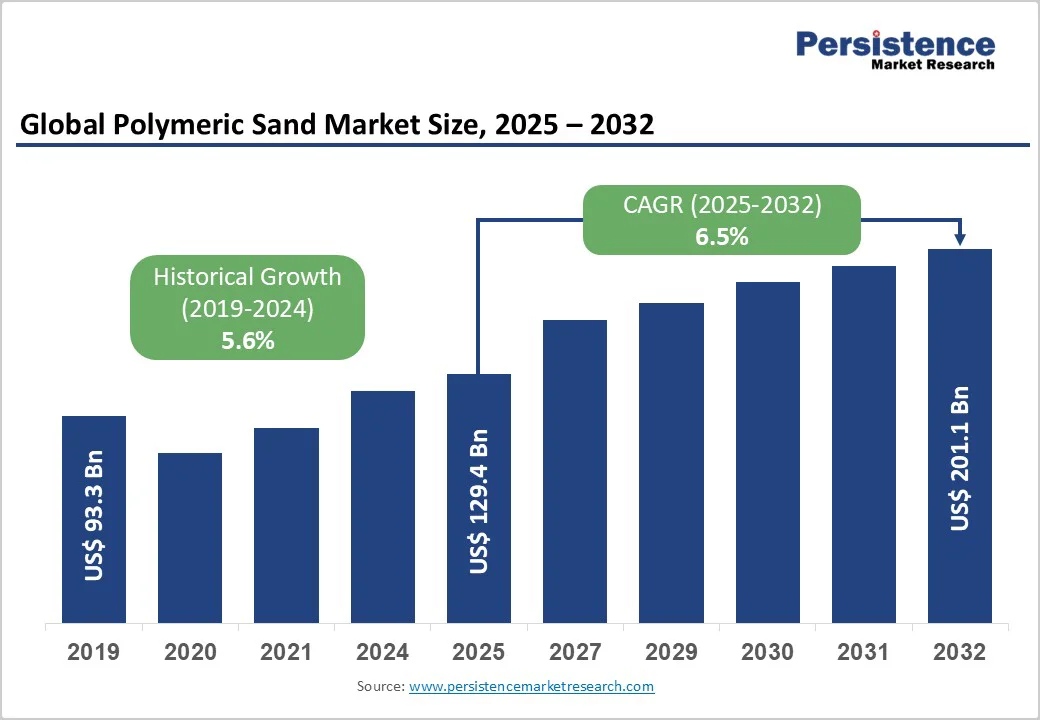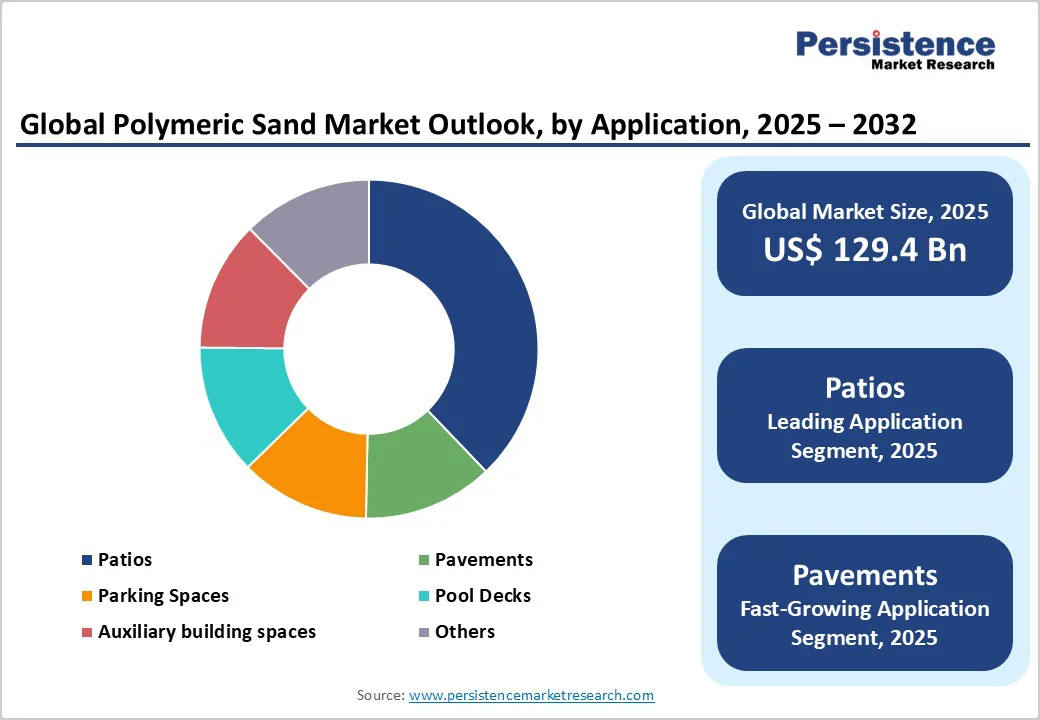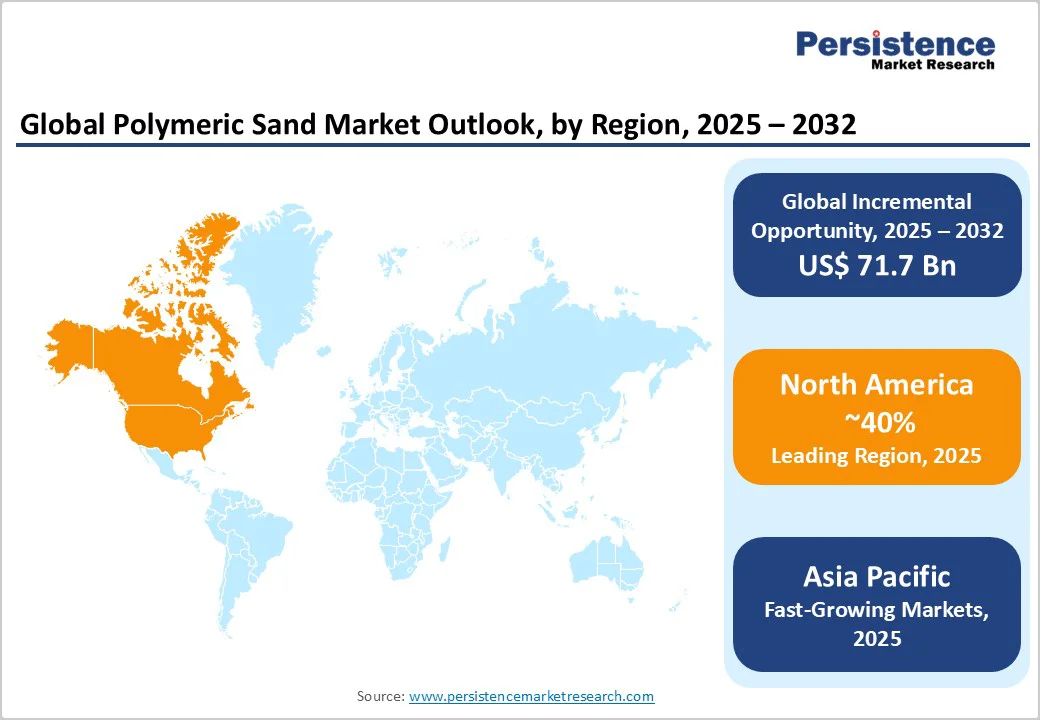ID: PMRREP35797| 200 Pages | 30 Oct 2025 | Format: PDF, Excel, PPT* | Chemicals and Materials

The global Polymeric Sand Market size was valued at US$129.4 Bn in 2025 and is projected to reach US$201.1 Bn by 2032, growing at a CAGR of 6.5% between 2025 and 2032. The primary driver of this growth is the surging demand for durable and low-maintenance hardscaping solutions amid rapid urbanization and infrastructure development worldwide.
The U.S. Census Bureau reports that construction spending reached $2,136.2 billion in June 2025, reflecting a 3.7% increase from 2024, as reported by trade credit analyses, underscoring the expansion of residential and commercial projects that use polymeric sand for joint stabilization in pavers.
| Key Insights | Details |
|---|---|
|
Polymeric Sand Market Size (2025E) |
US$129.4 Bn |
|
Market Value Forecast (2032F) |
US$201.1 Bn |
|
Projected Growth CAGR (2025-2032) |
6.5% |
|
Historical Market Growth (2019-2024) |
5.6% |

Urbanization continues to drive demand for efficient paving materials, such as polymeric sand, which offers superior joint stability and erosion resistance in high-traffic areas. According to the U.S. Census Bureau, total construction spending reached $2,139.1 billion in July 2025, with nonresidential projects accounting for $1,240.4 billion, driven by public-sector investments in roads and public spaces. This growth, up 0.1% from June 2025, highlights how governments and developers prioritize durable solutions to support expanding urban landscapes.
Polymeric sand's ability to deter weeds and insects aligns with these needs, reducing long-term maintenance costs by up to 30% compared to traditional sand, as noted in CMHA technical guidelines. Consequently, its adoption in infrastructure projects enhances pavement performance, fostering market expansion in regions undergoing rapid city development.
The boom in home improvement activities is significantly boosting polymeric sand usage, particularly for patios and walkways, as homeowners seek aesthetic and functional outdoor enhancements. Data from construction reports indicate that residential construction spending reached $898.7 billion in July 2025, up 0.1% month over month and reflecting sustained interest in outdoor living spaces. This trend is supported by the Interlocking Concrete Pavement Institute (ICPI) standards, which recommend polymeric sand for its fast-setting properties and compliance with ASTM C144 for graded sand binders. By providing a haze-free finish and stabilizing pavers against weather elements, it minimizes callbacks for repairs, appealing to DIY enthusiasts and professionals alike. As disposable incomes rise, this driver is expected to sustain demand, integrating seamlessly with broader trends in the Construction Chemicals Market for innovative binding solutions.
The elevated cost of polymeric sand compared to conventional alternatives poses a challenge, limiting adoption in cost-sensitive markets and emerging economies. Raw material expenses, including polymer binders and fine silica, have fluctuated due to supply chain disruptions, with chemical industry revenues reaching $5 trillion globally in 2021 but facing upward pressure from energy costs. This makes polymeric sand 20-30% more expensive, deterring small-scale contractors and budget projects, as highlighted in industry analyses on construction material affordability.
Furthermore, the need for specialized application techniques adds labor expenses, exacerbating barriers in regions with limited access to trained installers. Overall, these factors hinder widespread penetration, particularly in residential segments where price sensitivity is high, potentially slowing market momentum despite its durability benefits.
Limited end-user awareness of polymeric sand's advantages over regular sand restricts its market growth, compounded by shortages of skilled labor for proper installation. Construction sector reports note that, while public spending on highways rose to $100 billion in the U.S. by 2021, many projects still rely on traditional methods due to unfamiliarity with advanced materials such as polymeric sand.
The CMHA technical bulletins stress that improper application can lead to haze or erosion issues, requiring expertise in dry-sweeping and water activation, which is scarce in developing areas. With global urbanization straining labor resources, this restraint impacts efficiency, as untrained workers may opt for easier, albeit less durable, options. Consequently, education gaps and workforce challenges undermine the potential for broader adoption in both commercial and municipal applications.
The shift toward eco-friendly construction presents a key opportunity for polymeric sand in permeable paving systems, aligning with global sustainability goals and reducing stormwater runoff. Innovations in dust-free and water-permeable formulations are gaining traction, as evidenced by ongoing developments in polymer binders that enhance environmental compliance. For instance, urban planning initiatives in smart cities emphasize low-maintenance materials, and the CMHA promotes polymeric sand for its role in LEED credits through recycled-content requirements.
Such opportunities are particularly promising in the residential segment, where demand for green hardscaping is projected to rise with increasing tourism-driven landscape projects. By aligning with trends in the Road Maintenance Machinery Market, companies can capitalize on infrastructure upgrades and generate significant revenue as regulations favor sustainable alternatives over the next decade.
Growing investments in public infrastructure offer substantial opportunities for polymeric sand in commercial and municipal end-uses, especially for durable walkways and parking areas. Recent data show nonresidential construction at $1,240.4 billion in July 2025, with the lodging and commercial subsectors expanding amid a tourism recovery.
Recent events on urban beautification projects highlight its use in preventing joint erosion in high-traffic zones, as per ICPI guidelines for vehicular applications. This positions market participants to target the fastest-growing segments like pool decks and auxiliary spaces, supported by policies promoting resilient materials. As the Traffic Road Marking Coatings Market evolves, opportunities arise for bundled solutions in streetscaping, promising high demand and innovation in weather-resistant products through 2032.
Polymeric Sand leads the product type category with an approximate 82% market share, driven by its superior binding properties and versatility in hardscaping applications. This dominance stems from its ability to harden upon water activation, providing long-lasting joint stability while inhibiting weed growth and erosion, as recommended by CMHA standards for interlocking pavers.
Authentic data from construction associations indicate that polymeric sand outperforms dust variants in durability tests, particularly in residential patios where it reduces maintenance by locking pavers effectively against freeze-thaw cycles. Its compliance with ASTM C144 graded-sand specifications further justifies its lead, making it the preferred choice for professionals seeking haze-free results and an enhanced pavement lifespan in diverse climates.
Patios dominate the application segment with around 40% market share, attributed to the rising popularity of outdoor living enhancements in residential settings. This leadership is supported by surging home improvement trends, where polymeric sand ensures slip-resistant and aesthetically pleasing surfaces, aligning with ICPI installation guidelines for narrow joints.
Statistics from construction spending reports show residential investments fueling patio projects, with polymeric sand's fast-setting nature minimizing installation time and costs. Its role in preventing insect intrusion and stabilizing pavers under foot traffic solidifies its position, especially as consumers prioritize durable, low-maintenance options for leisure spaces.
Residential holds the leading position in the end-use category, with about 50% market share, driven by widespread adoption in home landscaping and DIY hardscaping. This supremacy is evidenced by the U.S. Census Bureau data showing residential construction at $898.7 billion in July 2025, reflecting homeowner investments in patios and walkways.
Polymeric sand's ease of use and weed-resistant properties make it ideal for individual projects, as per CMHA maintenance guides that highlight its longevity in non-vehicular areas. With urbanization driving backyard transformations, its preference over traditional fillers underscores sustained demand in this segment.

North America exhibits robust trends in the Polymeric Sand Market, led by the U.S.'s dominant construction sector and stringent regulatory frameworks promoting durable paving. The region's innovation ecosystem, supported by the CMHA, drives adoption through technical standards like ASTM C144, ensuring high-performance jointing in residential and commercial projects. Recent developments, such as increased public spending on infrastructure reaching $2,139.1 billion in July 2025, highlight U.S. leadership in utilizing polymeric sand for erosion control in urban walkways.
Regulatory emphasis on sustainable materials further accelerates growth, with agencies enforcing permeable designs to manage stormwater, positioning polymeric sand as a key solution in hardscaping innovations.
Europe's Polymeric Sand Market trends focus on regulatory harmonization and performance in key countries like Germany, U.K., France, and Spain, where sustainability directives boost demand. The European Union's green building policies encourage low-maintenance pavements, with polymeric sand's eco-friendly formulations aiding compliance in landscaping projects. In Germany and France, infrastructure upgrades integrate it for weed prevention, supported by national construction statistics showing steady growth in outdoor spaces.
Performance analysis reveals strong uptake in U.K. and Spain for patios, driven by harmonized standards that favor durable binders, enhancing market dynamics amid rising real estate activities.
The Asia Pacific Polymeric Sand Market is characterized by dynamic growth in China, Japan, India, and ASEAN countries, leveraging manufacturing advantages and urbanization. Rapid infrastructure expansion in India and China utilizes polymeric sand for pavements, with government investments mirroring global trends in construction chemicals. Japan's focus on resilient materials post-disaster recovery supports its application in commercial spaces, while ASEAN benefits from cost-effective production.
Growth dynamics are amplified by rising disposable incomes, enabling residential adoption and aligning with the Construction Chemicals Market for innovative joint solutions in emerging economies.

The Polymeric Sand Market exhibits a moderately consolidated structure, with key players focusing on expansion through acquisitions and R&D to develop eco-friendly formulations and capture share in growing infrastructure segments. Companies employ strategies like product innovation for permeable applications and partnerships with construction associations to enhance visibility. Key differentiators include haze-free technologies and compliance with ASTM standards, while emerging models emphasize sustainable supply chains and digital tools for installation guidance.
Techniseal (Canada), a leader in jointing solutions, dominates with innovative products such as NextGel technology, offering haze-free polymeric sand for residential applications; its strong portfolio and R&D focus drive 20% market share through global distribution.
Sakrete (USA), known for construction materials, excels in high-performance polymeric sand compliant with ICPI standards, supporting commercial projects with durable, weed-resistant options and leveraging manufacturing scale for broad accessibility.
Alliance Designer Products (Canada), post-acquisition growth, specializes in hardscaping sands, emphasizing sustainability and wide-joint compatibility, and has contributed significantly through expanded product lines for patios and walkways.
The global Polymeric Sand Market is expected to reach US$ 201.1 Bn by 2032, growing from US$ 129.4 Bn in 2025 at a 6.5% CAGR, driven by construction expansions.
Key drivers include urbanization and rising infrastructure investments, with global construction spending at $2,139.1 billion in 2025, alongside home improvement trends favoring durable jointing solutions.
Polymeric Sand leads with 82% share, due to its binding strength and compliance with ASTM C144 standards for superior pavement stability.
North America leads, powered by U.S. regulatory frameworks and construction growth, accounting for over 35% share in durable hardscaping applications.
Sustainable permeable paving presents a major opportunity, supported by eco-policies and innovations in recycled formulations for urban infrastructure projects.
Leading players include Techniseal, Sakrete, and Alliance Designer Products, recognized for innovative products and strong market influence in jointing solutions.
| Report Attribute | Details |
|---|---|
|
Historical Data/Actuals |
2019 - 2024 |
|
Forecast Period |
2025 - 2032 |
|
Market Analysis |
Value: US$ Mn/Bn, Volume: As Applicable |
|
Geographical Coverage |
|
|
Segmental Coverage |
|
|
Competitive Analysis |
|
|
Report Highlights |
|
By Product Type
By Application
By End-use
By Region
Delivery Timelines
For more information on this report and its delivery timelines please get in touch with our sales team.
About Author